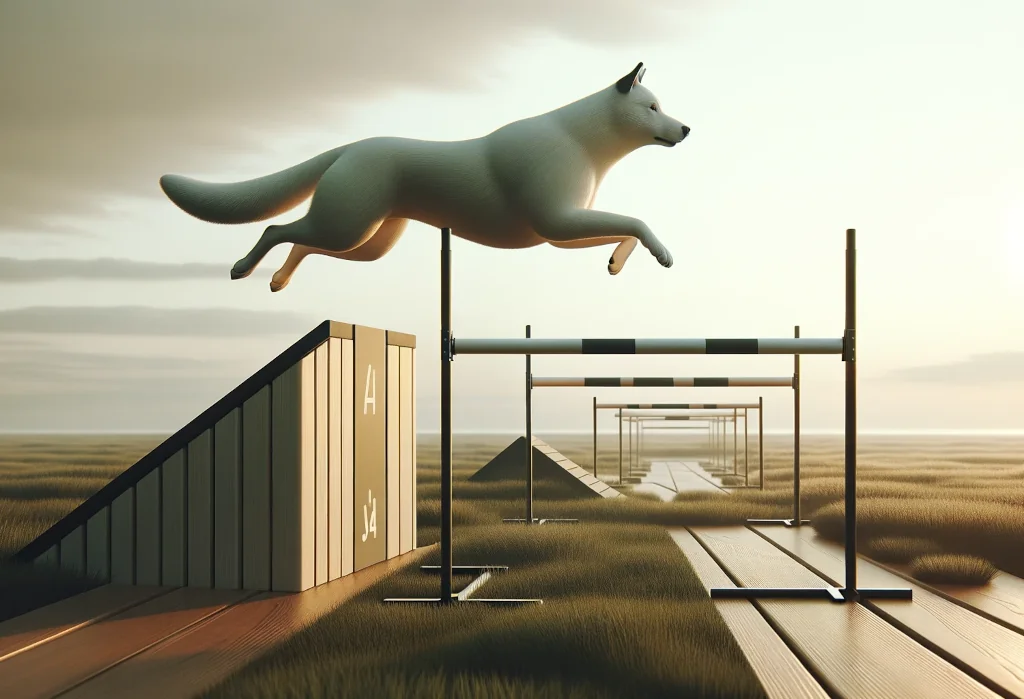Sometimes, the biggest obstacle isn’t the course itself, but not knowing where to start. Welcome to the ultimate guide on turning your backyard into a fun, engaging agility course that both you and your furry friend will love.
This post promises you a straightforward, step-by-step approach to designing, understanding, and training for agility courses right at home – turning daunting into doable.
Key takeaways:
- Agility training boosts your dog’s physical health and mental acuity, while strengthening your bond.
- Start with simple, homemade obstacles like jumps from PVC pipes and weave poles, increasing complexity gradually.
- Avoid common training pitfalls by keeping sessions short, sweet, and positively reinforced with varied rewards.
Why Should Your Dog Try Agility Training?
Ever watched a dog zipping through an agility course and thought, “My Fido could totally do that”? Well, guess what? Your dog can absolutely learn to tackle an agility course, and there are loads of reasons why they should give it a try.
First off, agility training is a fantastic way to get your fur baby up and moving. It keeps them physically fit, burning off excess energy that might otherwise go into less desirable behaviors (yes, we’re looking at that chewed-up couch). But it’s not just a physical workout; it’s a mental one too. Navigating through an agility course requires focus, memory, and problem-solving, which can significantly boost your dog’s mental acuity.
Then there’s the bonding aspect. Working together to conquer an obstacle course strengthens the bond between you and your dog like few other activities can. It’s teamwork at its best. Additionally, agility training can work wonders for a dog’s confidence and obedience. Facing and overcoming challenges can make shy dogs more confident and give high-energy dogs a constructive outlet. All in all, dabbling in agility training offers a plethora of perks for both you and your loyal companion.
What Do You Need to Start?
Ready to leap into agility training with your dog? You don’t need a lot to get started, which is the beauty of it. The essentials include:
- Jumps: The most basic of agility obstacles. You can create jumps out of PVC pipes or even broomsticks supported by buckets or plant pots.
- Tunnels: Commercial agility tunnels can be pricey, but a large, sturdy cardboard box with both ends open can serve as an excellent starting point.
- Weave Poles: Stick some slalom poles or even sticks in the ground, spaced well enough apart for your dog to weave through.
Here’s a pro tip most guides won’t tell you: When just starting, use furniture to create a makeshift course inside your house. It’s a unique way to introduce your dog to the idea of navigating through obstacles in a familiar environment, making the transition to outdoor equipment smoother.
Remember, agility is about fun and bonding. You don’t need top-of-the-line gear to begin, just creativity and a positive attitude.
How Can You Train Your Dog for Agility Courses?
You’ve got your makeshift agility course set up, and you’re ready to start training your furry friend. Here’s how to ensure a fun and fruitful training session:
- Start Simple: Begin with straightforward obstacles and gradually increase the complexity as your dog gets the hang of things. This builds confidence and makes the training process enjoyable for both of you.
- Use Treats and Praise: Positive reinforcement is key. Reward your dog with treats, praise, or a favorite toy whenever they successfully complete an obstacle. This reinforces their good behavior and makes them eager to tackle more challenges.
- Patience is Your Best Friend: Remember, every dog learns at their own pace. If an obstacle seems too difficult, it’s okay to take a step back and simplify things. The goal is to keep the experience positive.
A lesser-known trick that can significantly enhance your agility training is incorporating short, guided meditation or relaxation sessions before training begins. Just like athletes prepare their minds and bodies before a big game, helping your dog calm down and focus before starting the agility training can improve their concentration and performance. This could involve a calm petting session, a quiet walk, or performing some basic obedience exercises to get them in the right mindset.
Transitioning into the world of dog agility and obstacle courses isn’t just about physical exercise; it’s about opening a new channel of communication and trust between you and your dog. Remember, the journey is just as important as the destination. Keep things light, positive, and most importantly, fun, and you’ll both be navigating courses like pros in no time.
And that’s just the beginning. As your dog masters the basics, you can look forward to exploring more advanced techniques and obstacles together, continually strengthening the bond you share and enjoying the remarkable benefits agility training brings into your lives.
What Are Common Mistakes to Avoid in Agility Training?
Embarking on the agility training journey with your furry friend is an exhilarating experience, but it’s easy to trip over some common pitfalls if you’re not careful. Here’s how to side-step some of the most frequent missteps:
-
Pushing Too Hard, Too Fast : Just like us, dogs have varying learning curves. Expecting your pup to ace complex courses without mastering the basics first is a recipe for frustration. Start slow, celebrate the small victories, and gradually increase the difficulty.
-
Neglecting Positive Reinforcement : Dogs thrive on praise and rewards. Failing to recognize their efforts with treats or affectionate pats can dampen their enthusiasm. Remember, a happy dog is a motivated learner.
-
Lack of Consistency : Agility training requires regular practice and consistency. Sporadic sessions won’t cut it. Make training a part of your routine to sustain progress.
-
Ignoring Your Dog’s Physical Limits : Keep an eye out for signs of fatigue or strain. Not all breeds have the same energy levels or physical capabilities. Adjust the training intensity to suit your dog’s stamina and health.
-
Setting Unrealistic Expectations : Each dog progresses at their pace. Comparing your dog’s performance to others or expecting overnight success can lead to disappointment. Patience is your best friend in agility training.
Recognizing these pitfalls early on will help smooth your path and make agility training a rewarding adventure for both you and your dog.
How to Keep Your Dog Motivated and Engaged?
Keeping your dog’s tail wagging through agility training sessions requires a mix of creativity, patience, and observation. Here are some strategies to ensure your dog remains excited about training:
Vary the Obstacles
Introduce a variety of obstacles gradually to keep things interesting. Jumping through hoops one day and weaving through poles the next can stimulate your dog’s mind and prevent boredom.
Incorporate Playtime
Transition seamlessly between training and play. Tossing a frisbee or playing fetch right after a successful run can reinforce positive associations with agility training.
Train with Friends
Dogs are social creatures. Training alongside other dogs can spur friendly competition and elevate excitement levels. Just ensure all dogs get along well to avoid any hiccups.
Short and Sweet Sessions
Quality trumps quantity. Shorter, focused sessions ensure your dog doesn’t get overwhelmed or exhausted. Aim for 15 to 20 minutes, especially in the early stages.
Watch for Signs of Fatigue or Frustration
Keep a keen eye on your dog’s behavior. Signs of fatigue or frustration, like excessive panting or lack of interest, signal it’s time to call it a day. Pushing your dog too far can lead to negative associations with agility training.
Keep Rewards Varied and Exciting
Sticking to the same type of treat can become dull. Mix up rewards with different types of treats, playtime, or affection. Discovering what makes your dog’s heart sing will be your secret weapon.
Unique Tip: Capture and Reward Spontaneous Behaviors
Here’s a golden nugget most guides overlook : Start noticing and rewarding your dog’s spontaneous behaviors that align with agility training. Did your dog jump over a log during a walk? Reward them! This approach reinforces their natural inclinations towards agility behaviors, making formal training sessions even more intuitive for them.
Remember, maintaining positivity and enthusiasm is as crucial for you as it is for your dog. Your energy is contagious, and a fun-loving attitude can make all the difference. By avoiding common mistakes and leveraging effective motivation strategies, you’ll craft an agility training experience that both you and your dog look forward to every day.
Alex, a passionate animal lover, has experience in training and understanding animal behavior. As a proud pet parent to two dogs and three cats, he founded AnimalReport.net to share insights from animal experts and expand his knowledge of the animal kingdom.





